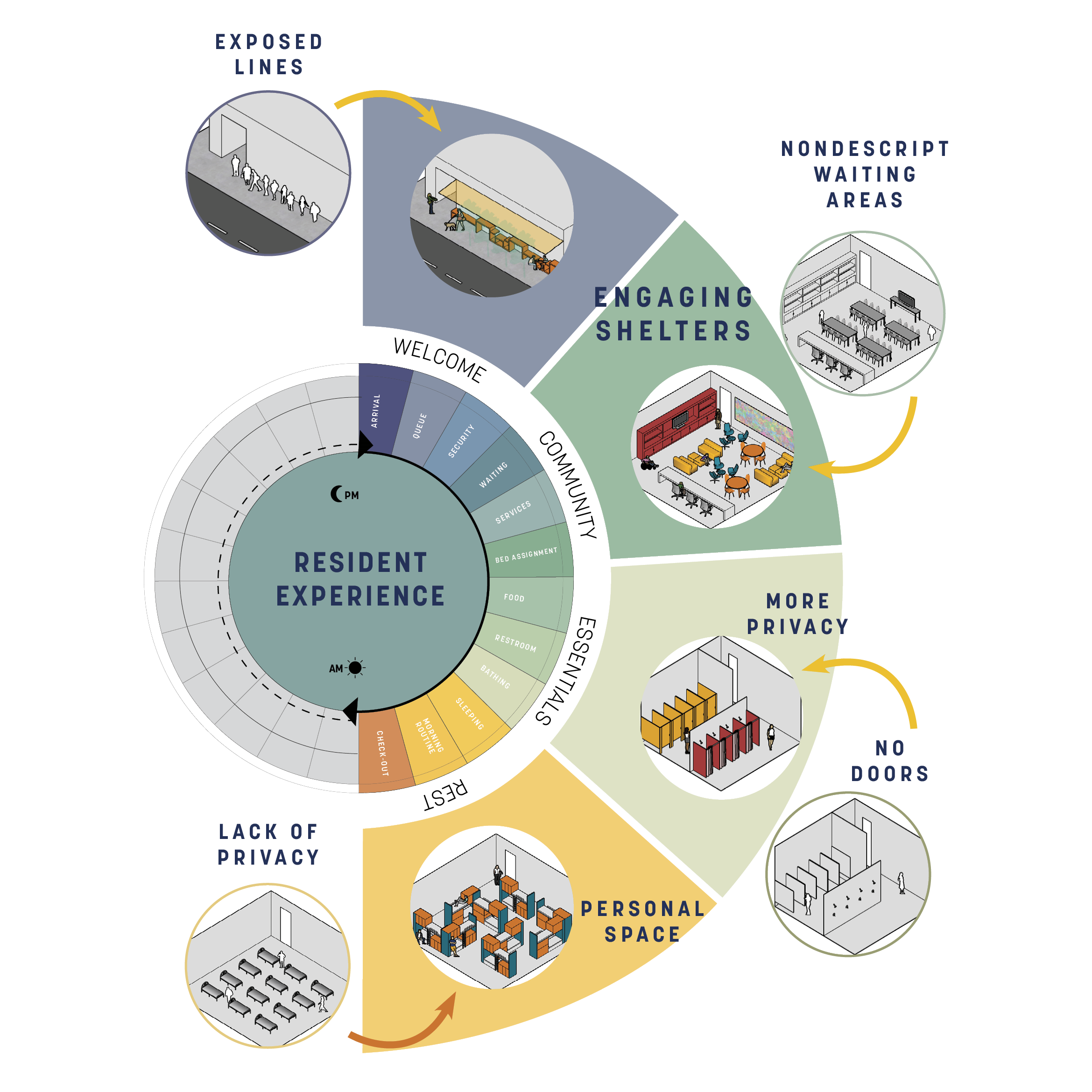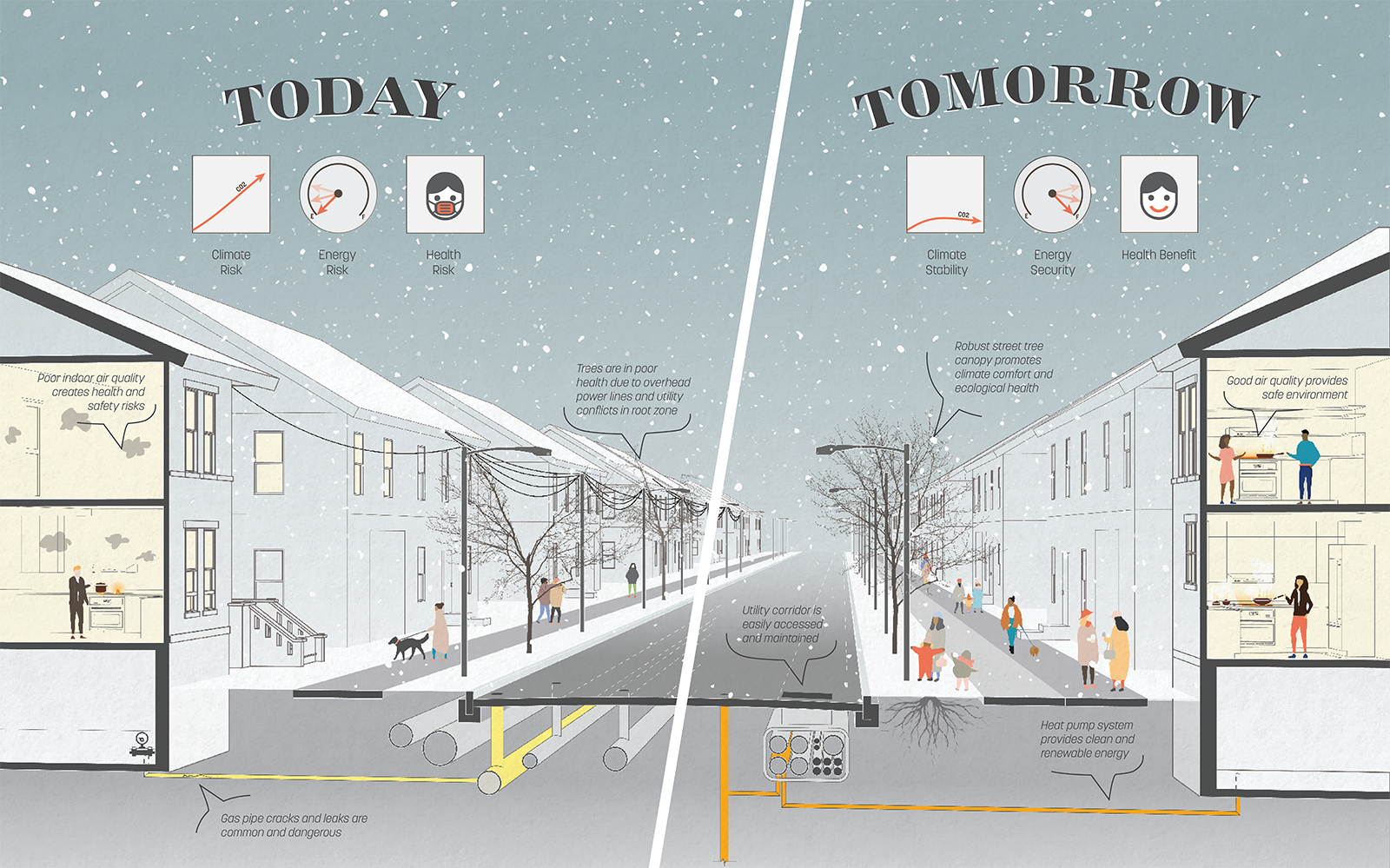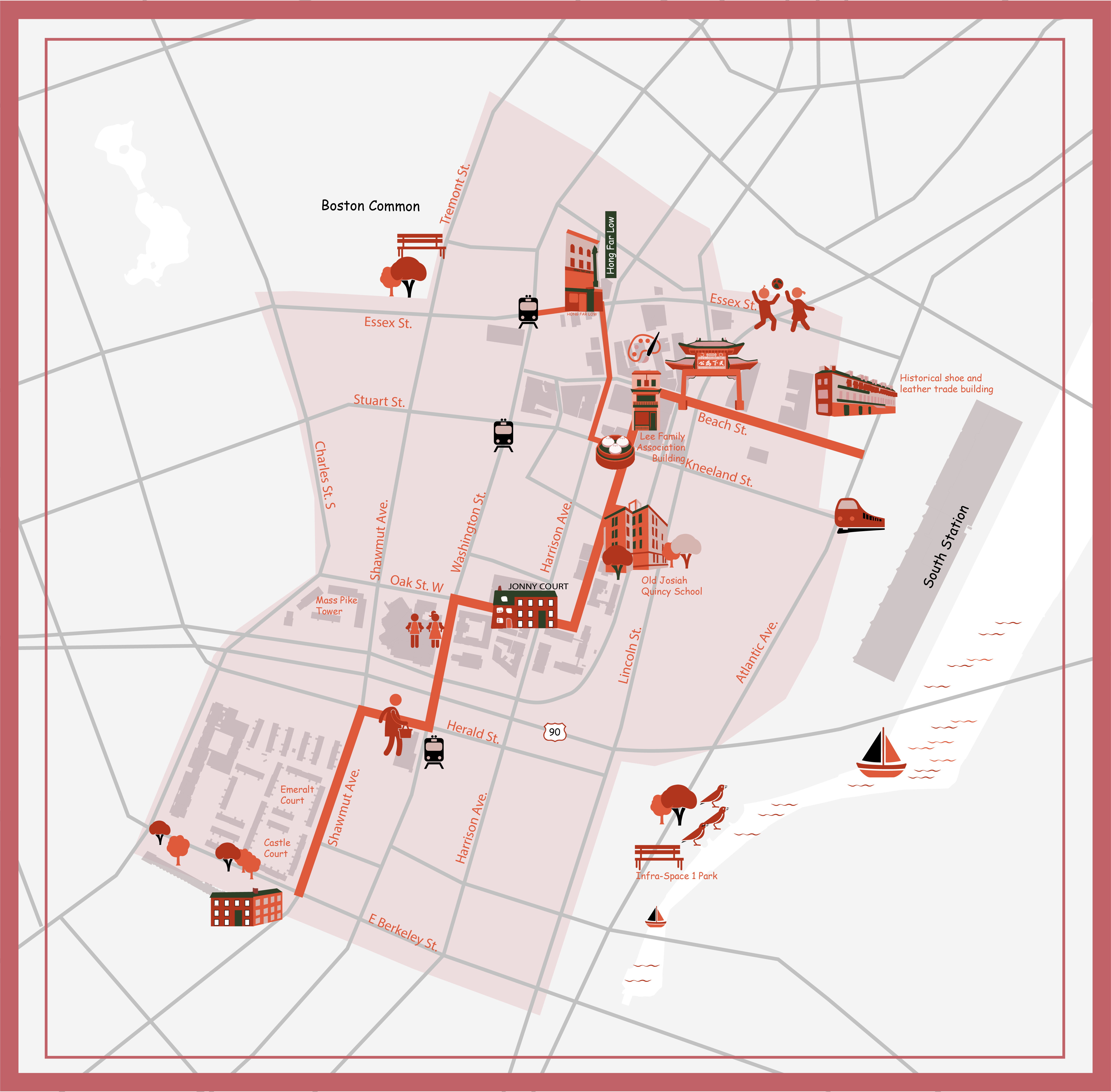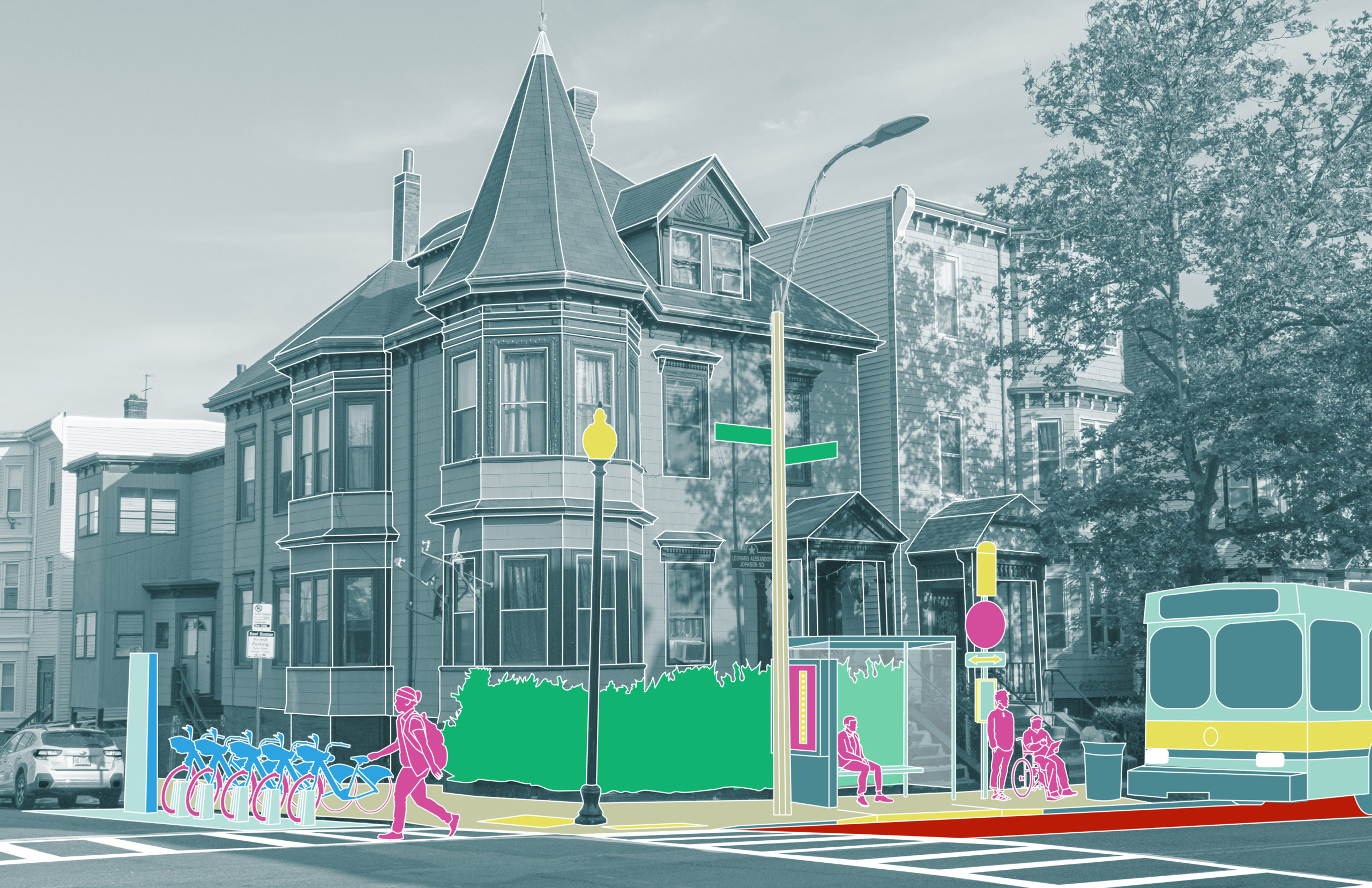Energy Shift Boston design charrette
Incubator at Sasaki
Explore the research from our 2019 Sasaki Foundation Design Grants research teams and our 2019 Community Grants teams below, and learn more in our 2019-2020 Design Grants Research publication.
2019 Research Teams
Designing Shelters for Dignity
New Models for Housing
Laila Fozouni, Elena Clarke
While Designing Shelters for Dignity believes everyone has the fundamental right to stable housing, the team acknowledges this will take a massive cultural shift and in the meantime many without housing are suffering in dehumanizing and degrading shelter conditions.
Physical designs of many emergency homeless shelters strip guests of dignity and privacy, and send the message to people without housing that they are not valued by society. The team believes changing the design of these spaces through input from shelter operators, staff, and guests can significantly improve the well-being of individuals sleeping in homeless shelters, at very little cost.
The Designing Shelters for Dignity team designed low-cost, nonstructural physical modifications to shelter spaces that can be easily fabricated and installed in emergency shelter spaces. The team focused attention on four main areas of shelters: the entrance where people queue, the waiting areas and common spaces, the restrooms, and the sleeping areas.
Possible modifications in these spaces include modifying the queue to decrease stigma and exposure to bad weather. They also include making common spaces more vibrant and welcoming, installing physical barriers between beds to increase the sense of privacy and safety, and modifying bathroom doors to protect the dignity of guests while ensuring safety during the addiction epidemic. Through advocacy efforts, the team has worked and will continue to work to promote these design modifications in the hope that they will serve as a model for new design standards implemented across multiple shelters.

Impact on resident experience graphic
Image courtesy Designing Shelters for Dignity in partnership with Sasaki

Energy Shift Boston concept graphic
Image courtesy Energy Shift Boston in partnership with Sasaki
Energy Shift Boston
Proactive Approaches to Climate Adaptation
Creative Community Building
Nathan Phillips, Keeley Bombard, Mary Brady, Ania Carmargo, Rickie Harvey, Zeyneb Magavi, Olivia Ruzzi, Audrey Schulman
Energy Shift Boston applied lessons learned from the 2018 Merrimack Valley Gas Disaster to pilot how communities can proactively develop resilience to energy system failures. The team engaged diverse communities across District 6 of Boston to identify and work with more than 100 households to screen their capacity to temporarily shift to electric heating and cooking in the event of a protracted gas outage, as occurred in the 2018 Merrimack Valley gas disaster.
Through the Energy Shift Boston project, the team discovered that the very starting point for an investigation of the ability of households to use temporary electric heating and cooking appliances—the main household electric service amperage—is both widely recorded and yet not readily accessible to emergency responders or city planners.
The key impact of this project is raising the opportunity for cities and towns to take advantage of discovering this data gap and to act to bring this crucial, simple piece of household information—for disaster resilience and long-term climate action—into a readily accessible manner. Moreover, because energy shift is a societal shift— in that short-term or long-term electrification of cooking and heating requires education and community engagement— this project has successfully piloted a grassroots, community-driven process for a transition to safer, cleaner, and more sustainable energy systems for all.
Visit the project webpage and learn more about HEET.
Rentify Chinatown
Creative Community Building
Tianyu Su, Weiyi Cao, Zhuangyuan Fan, Ruichen Ni, Helena Rong, Juncheng Yang
Understanding Boston’s Chinatown is at risk of gentrification and displacement, which exacerbates the loss of identity and memory, Rentify Chinatown aims to leverage the joint power of data analytics, digital tools, and in-depth interviews to document and explain the place-based identity of Chinatown.
Boston’s Chinatown is both home and the cultural and service hub for local communities as well as Chinese and Chinese American communities in outlying towns. The Rentify Chinatown team has created a shared database of quantitative and qualitative data for Boston’s Chinatown community organizations. At the same time, the team offers insights about local identity challenges and opportunities in the neighborhood.
In order to achieve these goals, with the help of community organizations including Chinatown Community Land Trust and Chinatown Progressive Association, Rentify Chinatown first collected historical information such as maps, numbers, and stories about the development and evolution of Chinatown. The team leveraged the data collected to create the Chinatown Historical Trail map, which featured significant places carrying the neighborhood’s identity. Then, to better understand how people visited and utilized Chinatown places, the team collaborated with their project partners and identified the patterns of people’s visits to Chinatown and how this valued Chinatown as a service and cultural hub. The team also developed WOW Chinatown, a crowdsourcing mapping tool embedded in WeChat—the messaging application widely used among Chinatown residents. In early 2021 (delayed due to COVID-19), the Rentify Chinatown research team, along with Boston Chinatown Neighborhood Center and Pao Art Center, will introduce this tool to residents and their friends and families, encouraging individuals to identify, post, and share their memories and sentiments about specific locations in Chinatown.
UPDATE: WOW Chinatown can now be searched and launched on the WeChat platform as “Rentify.” In light of the current pandemic, the team believes it is extremely urgent to create an outlet for the community to engage and express their opinions online. This tool will also help understand residents’ experiences during COVID-19, and their perception about the changes in Chinatown. The target audience is both Chinatown residents and anyone with an association to Chinatown (e.g., tourists, visitors, shoppers, people who work in Chinatown).
Combining this historical information, quantitative data, and personal perspectives, the team shared the layered results that document the identity of Boston’s Chinatown as an essential cultural and service hub, featured by a series of critical destinations. To preserve this significant identity, the team will document and exhibit those vanished locations online while advocating to protect the still existing places and physical structures.

Chinatown Historical Trail map
Image courtesy Rentify Chinatown
2019 Community Grants Teams

Mobility hub illustration
Image courtesy East Boston Mobility Hubs
East Boston Mobility Hubs
Innovation in Transit and Access to Mobility Choices
The Mobility Hubs Toolkit, intended for local and national distribution and use, explains mobility hubs, their benefits, and the various structural elements that can make up a mobility hub. For each element, the toolkit will include information on siting requirements, expected cost magnitude, who is the likely implementer of that piece of infrastructure, and examples. The toolkit also will walk readers through next steps if they would like to advocate for mobility hubs in their own neighborhoods.
The Mobility Hubs Toolkit, a TransitMatters project, will be written and presented to capture the interest of a non-technical audience, focusing on community organizations and members. The document will be eye-catching with a bright color scheme based on East Boston—the original community that inspired it; will only use open source fonts that can be properly read on any device; and will not include technical jargon. From a broader perspective, the toolkit will engage its audience by creating a vision, using illustrative user stories and mobility hub images to bring the benefits and possibilities of mobility hubs to life.
The team intends to contextualize the toolkit in today’s realities by including a prologue that describes why mobility hubs lie at the center of sustainable mobility, racial justice, and economic recovery. The toolkit will highlight how the 2020 COVID-19 pandemic and protests against police violence have made the need for modal choice and freedom of mobility more urgent than ever, and preview how mobility hubs help accomplish those goals by providing clear, actionable information about the modes available, and gathering those modes of transport all in one place. Additionally, when done well, the process of evaluating a site for a mobility hub guides people through a process of thinking about how different community members move through and reside in a space, which can reveal other inequities or safety concerns to address.
The toolkit will serve as an intellectual anchor for the team’s work promoting sustainable mobility in East Boston, Somerville, and Everett, and hopefully as a resource for advocates in these communities and elsewhere. While completing the research and writing, the team has been working to support city leaders who want to build mobility hubs in their cities and engage other community groups. The toolkit will advance the conversation across the region about what mobility hubs are and why they are necessary, just as TransitMatters advanced the conversation about Regional Rail.
Learn more about TransitMatters.
Knitting the Alewife: From Vulnerable to Vibrant
Creative Community Building
Sarah Howard, Doug Brown, Patricia Schroeder Loheed, Steven Nutter
Collective resilience touches every aspect of our shared lives and is only possible when owned and enacted by the people of the place in partnership with professionals, nonprofits, and government representatives. Knitting the Alewife is building a resilience learning community of community actors, municipal and state governments, university researchers, and local and regional nonprofits. The goals are to collaboratively understand and steward the Alewife as an eco-social system, find shared meaning in climate data, explore and evaluate alternative futures, and co-implement knitting projects across borders and boundaries of all kinds.
The project focuses on how to build the missing social and political infrastructure and frameworks that can support co-creation by all. Without these, design projects can be rooted in Power Over* techniques without realizing the full potential that leads to true resiliency in a Power With process.
Creation of the following supported this process:
- An Alewife cross-boundary housing study and visualization to inform resilient stewardship of the whole system by all
- Resilient whole-systems mapping and communication materials to co-create across boundaries
- A reframing of working design methods to enable community actors, government, and professionals to co-construct knowledge and action about resilience together across boundaries, to transform Power Over to Power With, towards greater spatial justice.
*Power Over is systemic injustice in which dominant cultural norms, behaviors, values, and identities are privileged in professional and everyday practice. Power With prioritizes mutualism and co-creation. (Concept from Patricia Evans)
Menotomy Manor (Arlington Housing Authority) case study flood risk due to sea level rise
Image courtesy Knitting the Alewife
